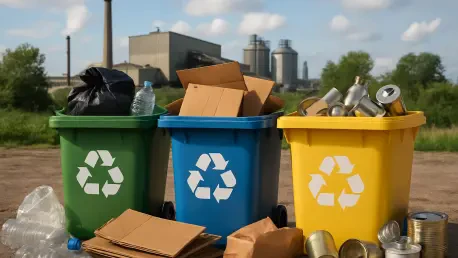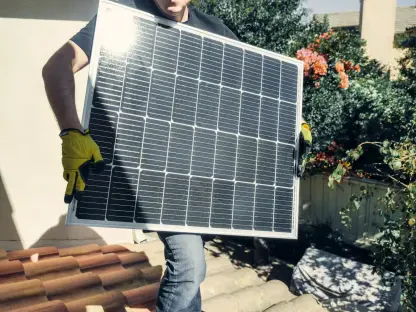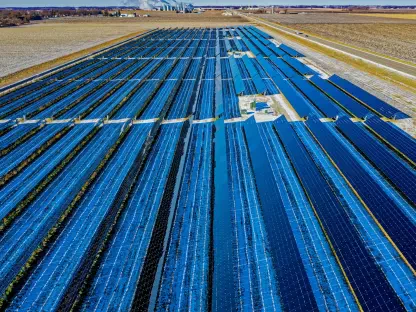Imagine a state taking a bold leap to combat plastic pollution by holding producers accountable for the lifecycle of their packaging, only to face a fierce legal battle from industry giants who are pushing back hard. Oregon has done just that with its groundbreaking Plastic Pollution and Recycling Modernization Act, the first active packaging Extended Producer Responsibility (EPR) law in the U.S. This pioneering legislation has sparked intense debate, culminating in a lawsuit from the National Association of Wholesaler-Distributors (NAW), representing around 30,000 firms. This roundup dives into diverse opinions, critiques, and insights from various stakeholders—environmental advocates, industry leaders, and policy analysts—to unpack the implications of this legal challenge and what it means for sustainability and economic fairness nationwide.
Exploring Oregon’s EPR Law: A Clash of Ideals and Interests
This legal dispute centers on Oregon’s innovative EPR framework, designed to shift waste management responsibilities to producers through a producer responsibility organization (PRO). The law’s rollout has drawn both praise for its environmental ambition and sharp criticism for its perceived inequities. By compiling perspectives from multiple sources, this section highlights the spectrum of reactions to the law and the NAW’s constitutional challenge, filed earlier this year.
The environmental community largely views Oregon’s approach as a transformative step toward a circular economy. Advocacy groups argue that assigning responsibility to producers incentivizes sustainable packaging design and reduces landfill waste. Many see this as a model that could inspire other states to prioritize ecological goals over short-term economic concerns, emphasizing the urgent need to address plastic pollution.
In stark contrast, industry representatives, particularly wholesalers and distributors, express frustration over the law’s structure. The NAW contends that their segment of the supply chain lacks control over packaging decisions yet bears a disproportionate burden under the current framework. This sentiment reveals a deeper tension between environmental mandates and operational realities, with businesses calling for a more equitable distribution of responsibility.
Dissecting the Legal Battle: Constitutional and Practical Concerns
Unpacking NAW’s Constitutional Arguments
The NAW’s lawsuit against Oregon’s EPR law raises critical questions about constitutional fairness, specifically citing violations of the dormant Commerce Clause and due process. Industry voices argue that the legislation impedes interstate commerce by placing uneven obligations on wholesalers who operate across state lines. This legal challenge underscores a broader concern that such policies might overstep state authority in regulating national markets.
Beyond legal theory, the practical implications of these arguments resonate with many in the business sector. Wholesalers highlight that they are often middlemen with little influence over product design or recycling outcomes, yet they face significant compliance costs. This perspective fuels the debate over whether Oregon’s law targets the wrong players in the supply chain, potentially setting a troubling precedent for other states.
Policy analysts offer a nuanced take, suggesting that while constitutional concerns are valid, they may also serve as a strategic tool for delaying enforcement. Some note that the NAW previously requested a one-year delay in implementation, hinting at a desire for more time to adapt rather than outright rejection. This angle points to a need for dialogue between regulators and industry to address underlying logistical challenges.
Mechanics of Oregon’s EPR Model and Industry Pushback
Oregon’s EPR program operates through a PRO, currently led by the Circular Action Alliance, which oversees waste management on behalf of producers. Environmental proponents commend this structure for creating a centralized system that streamlines recycling efforts and holds companies accountable. They argue it represents a forward-thinking approach that could reduce plastic waste significantly if implemented effectively.
However, wholesalers voice operational frustrations, emphasizing that their role in the supply chain does not align with the responsibilities imposed by the law. Many point out that compliance requires resources and expertise they often lack, creating economic strain without clear environmental benefits. This critique raises questions about whether the model’s design overlooks the practical limitations faced by certain stakeholders.
A balanced perspective from policy observers suggests that while the EPR framework has noble intentions, its execution may need refinement. There’s a growing call for clearer guidelines on responsibility allocation to prevent overburdening specific sectors. This insight highlights the importance of adaptive policymaking to ensure both sustainability goals and economic viability are met.
EPR Legislation Trends: National Growth and Resistance
Across the U.S., EPR laws for packaging are gaining traction, with seven states now having similar legislation in place. Environmental advocates celebrate this trend, noting increased support in states like Minnesota and Washington as evidence of a shifting mindset toward producer accountability. They believe Oregon’s pioneering status could catalyze a national movement if legal hurdles are overcome.
Industry resistance, however, remains a significant barrier, as seen in NAW’s active monitoring of programs in states like Colorado. Business leaders warn that regional variations in EPR approaches could create a patchwork of regulations, complicating compliance for companies operating in multiple states. This concern underscores the need for a more unified national strategy to balance environmental and economic priorities.
Analysts caution against viewing EPR laws as a one-size-fits-all solution, pointing to ongoing skepticism among some stakeholders about their long-term efficacy. The legal battle in Oregon is seen as a potential litmus test for how far states can push sustainability mandates without triggering widespread industry backlash. This dynamic suggests that future policies may need to incorporate more collaborative frameworks to mitigate conflict.
Sustainability vs. Economic Balance: Finding Common Ground
Environmentalists champion Oregon’s EPR law as a crucial step toward reducing plastic pollution, arguing that producers must bear the cost of their products’ lifecycle. This perspective frames the legislation as a necessary evolution in waste management, pushing for systemic change over incremental adjustments. Supporters believe that economic sacrifices are justified by the long-term benefits of a healthier planet.
On the flip side, industry critics, including those represented by NAW, describe the law as an overreach that unfairly penalizes certain supply chain segments. They argue that sustainability goals should not come at the expense of economic stability, especially for businesses with limited control over packaging outcomes. This viewpoint calls for policies that distribute burdens more equitably to avoid stifling commerce.
Some policy experts propose a middle ground, advocating for frameworks that incentivize sustainable practices while offering support for affected industries. Ideas like phased implementation or financial assistance for compliance costs are gaining attention as ways to bridge the gap between environmental ambitions and business realities. This balanced approach could serve as a blueprint for other states navigating similar challenges.
Key Takeaways from the Oregon EPR Dispute
Synthesizing these diverse opinions reveals a complex landscape where Oregon’s historic EPR law stands as both a beacon of environmental progress and a lightning rod for industry discontent. The NAW’s legal objections, rooted in constitutional and practical concerns, highlight critical flaws in responsibility allocation that could undermine the law’s effectiveness. Meanwhile, the growing adoption of EPR policies across the U.S. signals a broader cultural shift toward sustainability, albeit one fraught with tension.
For policymakers, the insights gathered suggest a need for clearer guidelines and inclusive stakeholder engagement to prevent legal and operational pitfalls. Refining EPR frameworks to ensure fair burden-sharing could help mitigate resistance while advancing ecological goals. This balance remains elusive but essential for the success of such initiatives.
Readers interested in this evolving debate are encouraged to track state-level EPR developments and explore how other regions address similar challenges. Engaging with local policy discussions or supporting advocacy for balanced sustainability measures can also contribute to shaping more effective solutions in the years ahead.
Reflecting on the Path Forward for EPR in America
Looking back, the legal challenge against Oregon’s packaging EPR law marked a pivotal moment in the struggle to harmonize environmental innovation with economic fairness. The clash of perspectives—from environmentalists’ optimism to industry’s apprehension—underscored deep divisions in how best to achieve a circular economy. This debate illuminated the complexities of implementing transformative policies in a diverse economic landscape.
Moving ahead, actionable steps emerged as critical for progress. Policymakers could prioritize collaborative platforms to integrate industry feedback into EPR designs, ensuring that no single sector bears undue weight. Additionally, exploring pilot programs or tiered compliance timelines might ease transitions for businesses while maintaining momentum toward sustainability. These strategies offer a roadmap for other states to refine their approaches, potentially turning legal battles into catalysts for stronger, more inclusive environmental policies.









